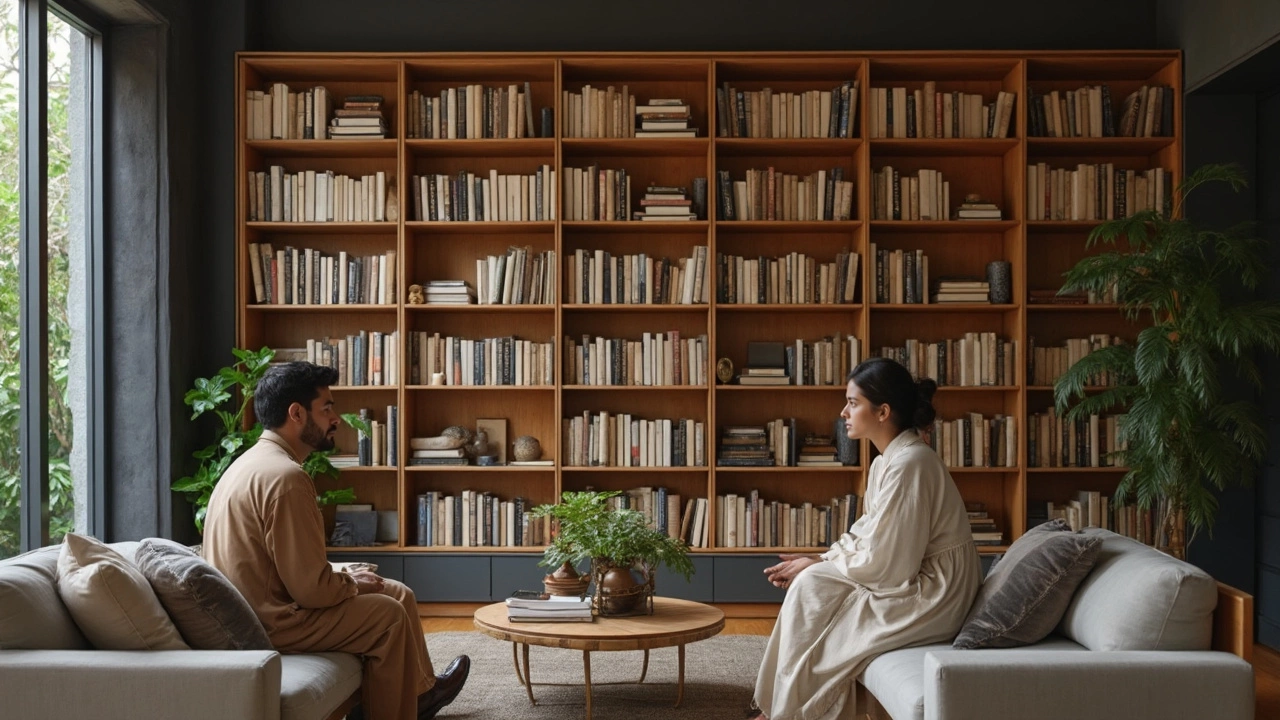If you've ever walked into a staged home, flipped through a home décor magazine, or scrolled endless Pinterest inspiration boards, you might have spotted a bookshelf that made you do a double take. Books, lined up in neat little rows, but not with their spines facing out—instead, the pages stare at you, spines pressed into the shadows. Some people think it's genius, others call it sacrilege. Why on earth would a designer hide the most useful part of a book? There's a lot more to this design move than just looking quirky. We're peeling back the curtain, page by page, on why designers put books backwards in bookcases.
The Curious Origins of the Backwards Book Trend
This trend didn’t just appear out of nowhere. The backwards book craze started to pop up in designer circles around 2013, first whispering through high-end interiors in Europe and making its way into North American design studios. Professional stagers were among the first to really run with it, hunting for a trick to simplify crowded bookshelves and make homes for sale look less personal, more universally appealing. Suddenly, instead of showing off a wild kaleidoscope of book spines—think bright reds, lurid yellows, shiny golds—they were flipping books around. All the cacophony on the shelf disappeared, and you got a soft whisper of cream, tan, and white. It was like the bookshelf took a chill pill.
There’s interesting psychology at play here. Designers realized that buyers walking into a home judged by first impressions. Book titles and colors cluttered up a shelf, screamed about the owner’s quirks or politics, maybe even turned someone off. Backwards books neutralized everything, offering a visual break and a blank slate that let any visitor imagine their own life in the space. It wasn’t about reading—it was about mood, about making a room feel more about serenity than story. It’s a little like serving plain white plates at a dinner party instead of patterned ones: They draw less attention, let the surroundings breathe.
But how far does it go? Flipping books worked great in photos, where the goal is one perfect shot more than function. In 2018, Architectural Digest called out the "backwards book" as the latest battleground between practicality and design. Overnight, more designers started playing with the trick, sparked by the photos and social feeds of people like Kim Kardashian and Kanye West, whose sprawling all-neutral LA mansion featured backwards books as part of its minimalist vibe.
Was this the beginning of the end for the humble spine? Hardly. But the backwards book look, love it or hate it, was here to stay. It’s provoked debate ever since. Authors, librarians, and bookish types declared it an affront to literature, while stylists and Instagram interior influencers praised its calm, monochrome aesthetic.
You might not know that in some conceptual art installations decades ago, artists used the "spine-in" display as a rebellion against commercialism, emphasizing the material over the marketed. Today, though, it’s most at home in modern minimalist and "Scandi-chic" spaces, where emptiness and openness are king.
The Design-Forward Motives: Aesthetics Over Functionality
Ask a designer why they flip books backwards, and you’ll get a surprisingly practical answer: it’s all about controlling the look. Bookshelves—the large, anchor pieces that they are—can either pull a room together or split it apart with visual noise. If you have a color-coded or mismatched collection, your shelf might look more like a collage than a stage-set. Flipping the books calms everything down. Suddenly, the shelf is a mat backdrop instead of a scratchy, attention-seeking canvas.
What’s happening visually is interesting. Human brains crave patterns and symmetry. Random splashes of spine colors can make a room feel unsettled. By turning books around, designers are creating a sort of "visual white noise." The creamy edges of pages make a softly textured wall, not a riot of styles, fonts, and colors. People report feeling a sense of order and relaxation in spaces styled this way, which is no accident. The home-staging firm Studio McGee has said that, in 71% of their staged homes, backwards books help create the "hotel room effect"—fresh, inviting, and relaxing, with zero clutter from reading material you might not even like.
The trend also grew alongside social media interior trends, which favor clean, shareable snaps. When you want the eye to focus on a few hero design objects—maybe a sculptural vase, a treasured art piece—no one wants a shelf full of Harry Potter and dog-eared cookbooks fighting for attention. It’s the same reason stylists hide cords behind couches, or match their throw pillows to their rugs: it keeps the eye roaming around the room, not getting hung up on busy details.
That’s not to say it isn’t divisive. A 2023 survey of 1,200 book lovers conducted by Book Riot found that 68% considered backwards shelving "ugly and impractical," while 19% admitted to loving the minimalist look, despite owning more unread books as a result. But there’s another group entirely who see the backwards-book trick as a clever hack for hiding embarrassing reads, battered paperbacks, or cheap editions that clash with expensive decor.
Some stylists even use backwards books to fill gaps left by real books—if you’ve got a huge built-in but not nearly enough novels, you can buy $2 thrift store paperbacks, flip them, and have your shelves looking full and rich without breaking the bank. It’s "book wallpaper" in a strangely literal sense. Plus, in set design for TV shows or films, backwards books have been a clever way to avoid copyright issues or distracting viewers with recognizable titles.

Reading vs. Styling: The Battle for Bookcase Soul
Sure, backwards books look great for five seconds, but what about the book lovers? This is where the argument heats up. To a reader, books aren’t just props. They’re worn companions, markers of taste and memory. Spine-out shelving is part history, part utility—you know exactly where your copy of The Great Gatsby lives, just by sight. Flipping books backwards, for many, feels like turning your friends’ faces to the wall.
Is it practical? Not really. If you’re the type who needs to grab a book in a hurry, backwards shelves are a nightmare. You’re doomed to pull book after book out, searching for that one favorite. Librarians have joked about their "anxiety" over the trend, since it completely undoes the entire classification system of most home libraries. Someone online even called it "the bookshelf version of decorative fruit bowls you’re not allowed to eat from."
But here’s the twist: not everybody actually reads the books on their shelves. A recent poll from The Guardian in 2024 found that 41% of people with home libraries admit they haven’t read at least a quarter of their books. For this crowd, stylish shelving is less about function and more about setting the scene—just as you’d arrange a bunch of old records or display coffee table books you’ve never cracked open. It’s bookshelf as art, not archive.
This cultural split goes beyond interior design. Some people see books as identity—showing off what you read, signaling your interests, even bragging, if we’re honest. Others are more interested in what the collection does for a space: it’s about the vibe, not the content. The backwards book puts that idea front and center, for better or for worse.
There’s even a middle ground. Some homeowners mix spine-in and spine-out shelves, designating one or two rows for backwards books to separate colors or ground the collection visually, while keeping most books ready for quick ID. Some wrap books in neutral paper or linen to get the same soft look, but add hand-written names on the spines for function and flair.
It’s not all high-concept either. Real estate agents have reported that staged homes with backwards books sell, on average, five days faster than those with cluttered or unreadable bookcases. It might sound like a superpower, but it’s just about making the space feel lighter and more edited.
Tips and Tricks: Do Backwards Books Right (If You Dare)
Want to try the backwards book look without losing your sanity? It’s about balance. Here are some real-world ideas and hacks for pulling it off successfully.
- Start with books you don’t need often or ones that don’t matter if you lose track of. Old textbooks, reference guides for hobbies you’ve outgrown, or thrift shop finds are good candidates.
- Mingle backwards books in with regular spine-out rows. This creates visual "rests" among busier shelves, and you’ll keep key reads handy.
- If you have matching series or lots of hardcover classics, stack those spine-out for a pop of color or to show off favorite titles. Use backwards books as room dividers.
- Save time by grouping books with similarly colored page edges. Some older editions have tan or red-tinted sides, which can add interest among all the pale pages.
- You can mark the bottom edge of backwards books with washi tape or tiny stickers so you can ID titles by shelf, without ruining the look.
- If you insist on all-backwards books, keep a simple shelf map on your phone or a small index in a drawer. Even designers admit they need to cheat sometimes.
- Try it for a specific season. Backwards books in summer, spine-out in autumn for a cozy, homey feel. No one says you have to pick forever.
You might want numbers. According to home staging data in table form:
| Method | Visual Appeal (Survey %) | Functionality (Survey %) | Buyer Interest (Avg. Rating/5) |
|---|---|---|---|
| Spine Out | 59 % | 84 % | 3.2 |
| Backwards Books | 78 % | 23 % | 4.1 |
| Color-Coded Spines | 65 % | 58 % | 3.6 |
The backwards look wins for style and buyer interest, but loses badly for functionality. There’s no denying it: sometimes, beauty beats brains.
Designers know that a home tells a story, even if you can’t read the spines. Next time you see a wall of backwards books, remember it’s not about erasing personality—it’s about setting a tone, making room for daydreams, or just keeping things chill. Want to shake things up at home? Sometimes, all it takes is turning a few books around. Just don’t let your book club catch you.

